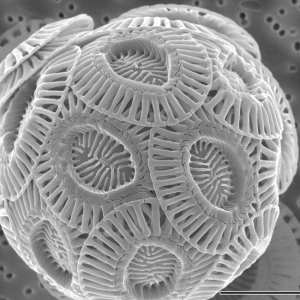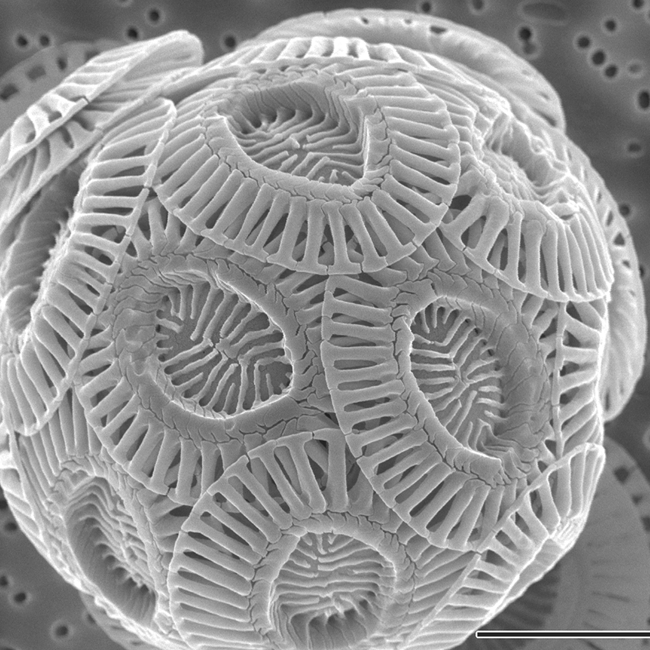Source: Hague, M., and M. Vichi (2018), A link between CMIP5 phytoplankton phenology and sea ice in the Atlantic Southern Ocean. Geophysical Research Letters, doi: 10.1029/2018GL078061
The Biggest Carbon Sink
The ocean plays a crucial role in regulating the earth’s climate by taking up excess heat and carbon dioxide from the atmosphere. The ocean surrounding Antarctica, called the Southern Ocean, absorbs a particularly large amount – nearly 30% of the carbon and 90% of the heat associated with anthropogenic climate change, which is the warming associated with fossil fuel burning by humans.
Tiny microalgae called phytoplankton are responsible for most of the transfer of carbon dioxide from the atmosphere to the ocean. Phytoplankton form the base of the marine food web and absorb carbon dioxide through photosynthesis, just like trees and other land plants. This carbon then gets stored in the deep ocean when the organisms die and sink to the seafloor. How important is this sinking of organic matter to the global carbon cycle? Scientists still don’t exactly know since it’s so difficult to measure phytoplankton activity in the ocean. Quantifying this pathway in regions that uptake a lot of carbon, like the Southern Ocean, is important to understanding and modeling atmospheric carbon dioxide concentrations and global climate.

Ice Impacts Phytoplankton
While measuring phytoplankton activity is already difficult, taking measurements in the ocean surrounding Antarctica is even more challenging due to its remote location and harsh weather. Because there is so little available data, studying the role of Southern Ocean phytoplankton in the carbon cycle is difficult using observations alone. Therefore, a recent study by Mark Hague and Marcello Vichi at the University of Cape Town compared observations with several different complex models to try to understand how sea ice impacts biological productivity in the Antarctic. Models, like the ones used in this study, that integrate physical, chemical, and biological processes are becoming increasingly important as we try to untangle the complex feedbacks that drive changes in ecosystems and climate.
One of the key results from this study is that models consistently predicted phytoplankton growth earlier in the year than was observed. This is a problem since properly accounting for phytoplankton activity is necessary to model marine ecosystems and the global cycling of nutrients. The researchers attribute the early growth to issues with how the model represents sea ice processes. Ice cover limits the amount of light (which is necessary for photosynthesis) that reaches the upper ocean. Therefore, models must accurately characterize sea ice extent in order to predict when and where there will be enough light to support phytoplankton growth.

In addition to modulating light availability, sea ice also impacts phytoplankton by changing the vertical structure of density layers (stratification) in the upper ocean. Melting of sea ice adds freshwater to the ocean, while sea ice formation injects salt. This in turn impacts the stratification because the density of seawater depends on the amount of salt in it. Since sea ice melting and formation impacts vertical mixing, it also controls the supply of nutrients to the surface from the deep ocean.
Sea ice itself also contains nutrients like iron that are necessary for phytoplankton growth. Thus the ice melt can actually fertilize blooms. Sea ice impacts phytoplankton through a number of mechanisms, and it is difficult to untangle these complex feedbacks. The results from Hague and Vichi suggest that current climate models may have biases in sea ice processes that inhibit them from accurately predicting phytoplankton growth. Furthermore, addressing these biases is necessary given the role that phytoplankton play in the marine food web and the global carbon cycle.
How Strong of a Sink?
Carbon concentrations in the Southern Ocean are controlled by a complex combination of interaction with the atmosphere, sea ice dynamics, and biological processes. Because of this, scientists have different hypotheses about how the Southern Ocean’s ability to absorb carbon will change in the future. Some studies suggest that sea ice retreat will expose the ocean to more sunlight, which will increase productivity and allow the ocean to absorb more carbon. Others hypothesize that increasing ocean temperatures and sea ice melt will cause the ocean to become more stratified and eventually take up less carbon. By investigating the relationship between sea ice variability and phytoplankton growth in climate models, this study can help us understand and predict how the ocean’s ability to regulate climate might change in the future.
I’m a physical oceanography PhD student at Scripps Institution of Oceanography in La Jolla, California. I use a combination of numerical models, observations, and remote sensing to investigate the role of the ocean in climate. I’m particularly interested in Southern Ocean dynamics, including air-sea-ice interactions and physical controls on biogeochemistry.

